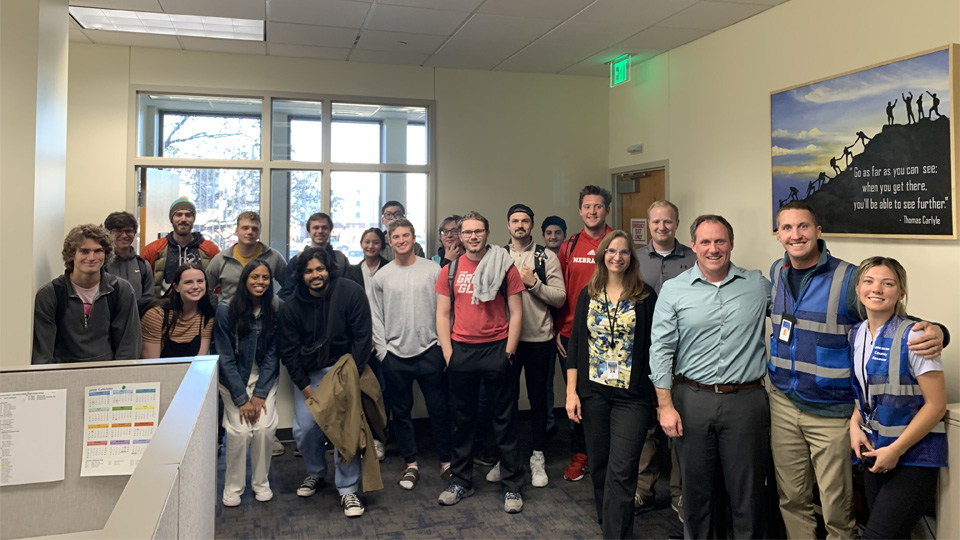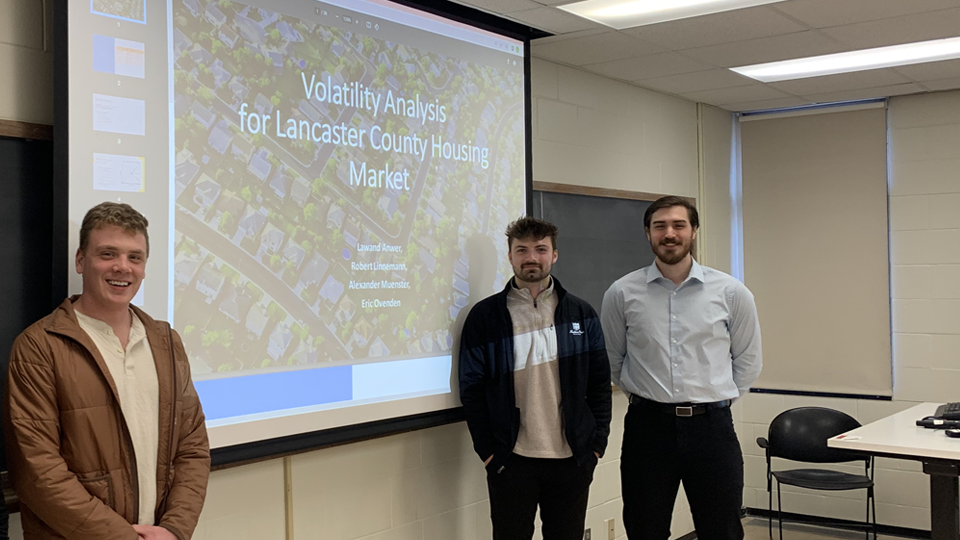
This semester, students in "MATH 435: Math in the City" collaborated with the Lancaster County Assessor's Office to study the local housing market using methods from mathematical statistics, machine learning, and economics.
In the interdisciplinary, hands-on course, students use mathematical modeling to understand and provide solutions for issues of local and national interest in collaboration with local organizations that provide data and consultation.
The Assessor's Office supplied data for home sales in Lancaster County from 2016 to August 2022, which is used to predict current home values to determine property taxes, and explained how the office uses complex data sets to create predictive models.
Students were encouraged to identify trends and useful relationships, Derrick Niederklein, Chief Field Deputy with the Assessor's Office, said, and they asked his team questions throughout the semester.
"The course is a great opportunity for students to experience the critical use of data in the public sector," he said. "Our office gained additional insights as well."
Students learned mathematical statistics and familiarized themselves with vocabulary, issues, and policies related to the U.S. and Lincoln housing markets, said Levi Heath, the course instructor and a postdoc research associate. They then proposed project ideas, which he and Austin Eide, the graduate teaching assistant, used to create the projects.
"Math in the City nurtures students' curiosity and creativity," Heath said. "It gives them practical experience that they can list on their resumes."
18 students worked in four groups to code models, analyze data, and write manuscripts to document their work. They presented their process and results to the Assessor's team, members of the Department of Mathematics, and peers on December 7 and 9.
The projects

Alexander Muenster, Robert Linnemann, and Eric Ovenden. Image courtesy Levi Heath.
Lancaster County Volatility Analysis
Alexander Muenster, Robert Linnemann, Eric Ovenden, and another student used methods from economics to assess the volatility of Lincoln's housing market. Their research analyzed Lancaster County's housing market data to define market trends of volatility for long-term security and trends of fragility for financial investments. The results could help inform homeowners and investors when making a decision and could inform prospective property owners and investors about the dynamics of the market.

Gabe Payson, Mitchell Finocchiaro, Yashaswi Mehra, Xuan Le, and Eric Liu. Image courtesy Levi Heath.
Comparing Neural Network and Regression Models in Predicting Lancaster County Housing Prices
Mitchell Finocchiaro, Xuan Le, Eric Liu, Yashaswi Mehra, and Gabe Payson built a model for predicting home prices using methods from machine learning. Comparing them to a linear model similar to one that the Assessor's Office might use, they concluded that their linear model was more accurate.
"Collaborations with fellow students led to sharing a lot of knowledge and perspectives," Mehra said, "and the project-based model helped me learn a lot of data analysis from scratch."

Parker Zach, Mac DePriest, Shaunak Datta, Shivani Mudhelli, and Jillian Baker. Image courtesy Mike O'Connor.
An Analysis of the Factors Contributing to a Home's Value
Jillian Baker, Shaunak Datta, Mac DePriest, Shivani Mudhelli, and Parker Zach used mathematical statistics to determine the qualities of a home that contribute the most to its price.

Cade Cutler, Mason Malecha, Cole Johnson, and Alexander Miller. Image courtesy Mike O'Connor.
Projecting Neighborhood Growth with a Decision Tree
Cade Cutler, Cole Johnson, Mason Malecha, and Alexander Miller utilized machine learning to develop methods for predicting when a neighborhood's value would grow faster than the average growth of Lincoln's housing market. Using a decision tree, they were able to correctly analyze about 80 percent of high growth rate neighborhoods, Cutler said. Then, using linear regression, they identified factors that were more impactful on price.
"Math 435 is a great course that allows you to gain knowledge on [a current issue] and test that knowledge with analysis," Cutler said. "Working in groups all semester is something that I believe teaches great teamwork and communication. I enjoyed learning more about the housing market; I gained knowledge on factors that affect homes, and what causes the rising and falling in home prices. It was a great learning experience and way to test our knowledge!"
Challenge Accepted
The scope of the Assessor's work ties into two of the university's Grand Challenges, Heath said: "Anti-Racism and Racial Equity" and "Science and Technology Literacy for Society". Not every home is sold each year, so some homes are over- or under-valued. The Assessor’s team needs to limit this error and construct equitable models—so that buyers pay a fair amount—and they need to be able to justify their valuations to the general public.
Over time, the Math in the City course has also connected to "Climate Resilience", "Health Equity", "Anti-Racism and Racial Equity", and "Sustainable Food and Water Security", according to Petronela Radu, chair and Leland J. and Dorothy H. Olson Professor in the Department of Mathematics.
The Grand Challenges initiative ties back to the university's N2025 Strategic Plan, which identifies experiential learning as key to the student experience at Nebraska. In the College of Arts and Sciences, which houses the department, it's a core component of both the college-level Strategic Plan and the vision of the college's Academic and Career Advising Center, summed up in the equation "Academics + Experience = Opportunities." The center encourages students to complement academics with experience-building through research, student organizations, internships, education abroad, and service learning—outlined in the center's Four-Year Success Plan.
Experiences like the collaborative component of MATH 435 give students the chance to connect academics to situations they may encounter in their careers.
"In the presentations I attended, students said they loved their experience with the course because it was related to a real-world problem which they loved learning more about," Radu said. "Students were so immersed in the work that some of them delved into [previously published] research projects, reading a dozen papers to gain expertise for the analysis they needed to perform."
Radu started the course in 2006 and received a National Science Foundation grant in 2009, in collaboration with a former faculty member, to develop the course as a model for export to other universities.
She said collaborating with the Assessor's Office was a highlight of the course this semester—the students appreciated their expertise and input. Niederklein and Heath both said working with the students was rewarding.
"It turned out to be quite fun!" Niederklein said. "Each group was impressive in presenting their findings and describing the depth of their analyses. The student's review of common housing data was helpful to me and my team and exposed additional market insights."
In most STEM courses, students complete assignments with a limited scope, Heath said. In Math in the City, students identify and analyze a problem and propose a solution.
"This promotes an incredible amount of creativity," he said. "Often students utilize knowledge from classes beyond their mathematics courses and, in every case, they must learn a new field or topic on their own. Instructors of Math in the City function more as advisors than as teachers and promote independent learning."
Radu said students often invite friends and family members to attend the presentations.
"It is one of the courses that we highlight when talking to prospective students," she said.


